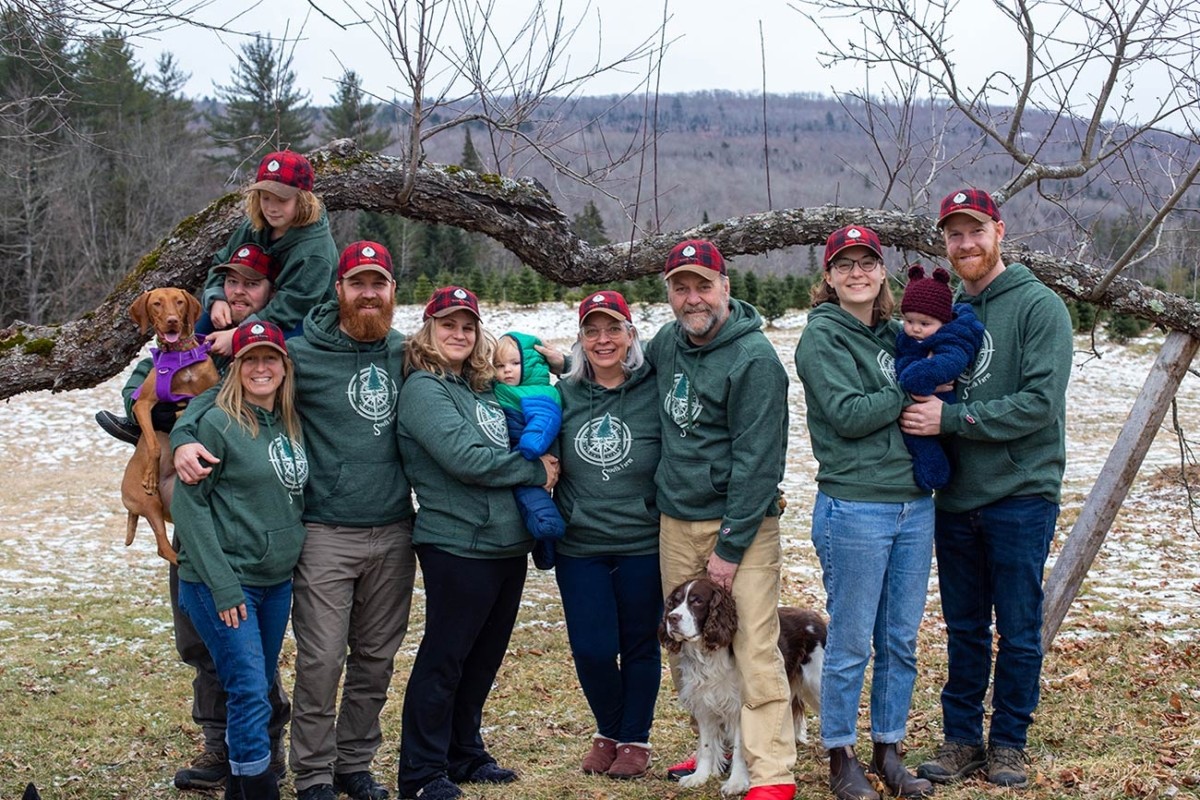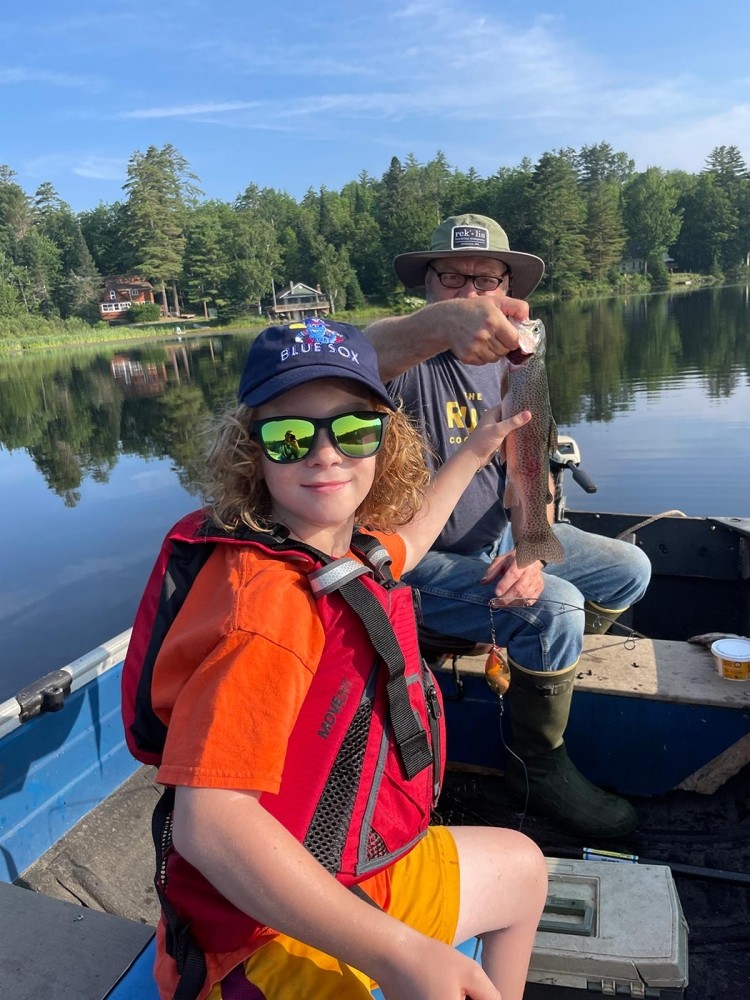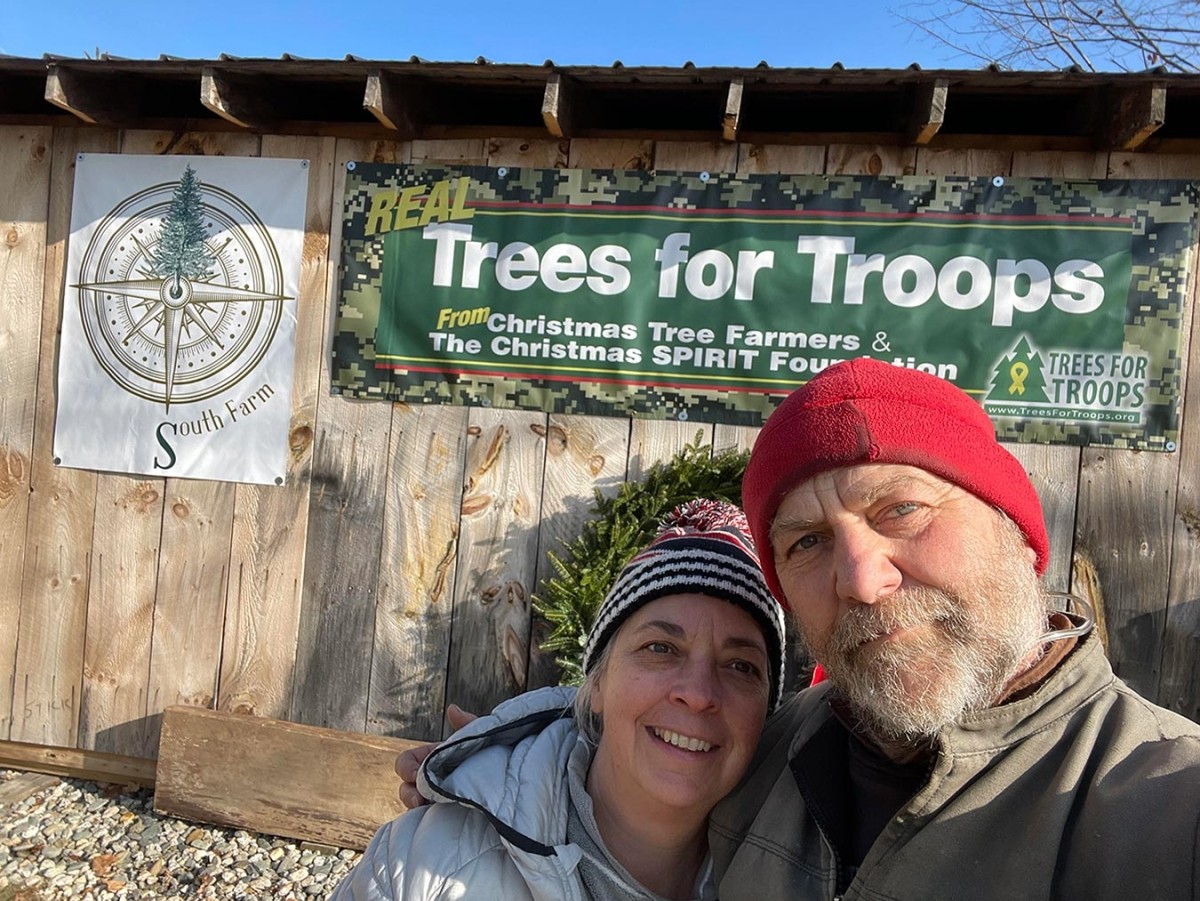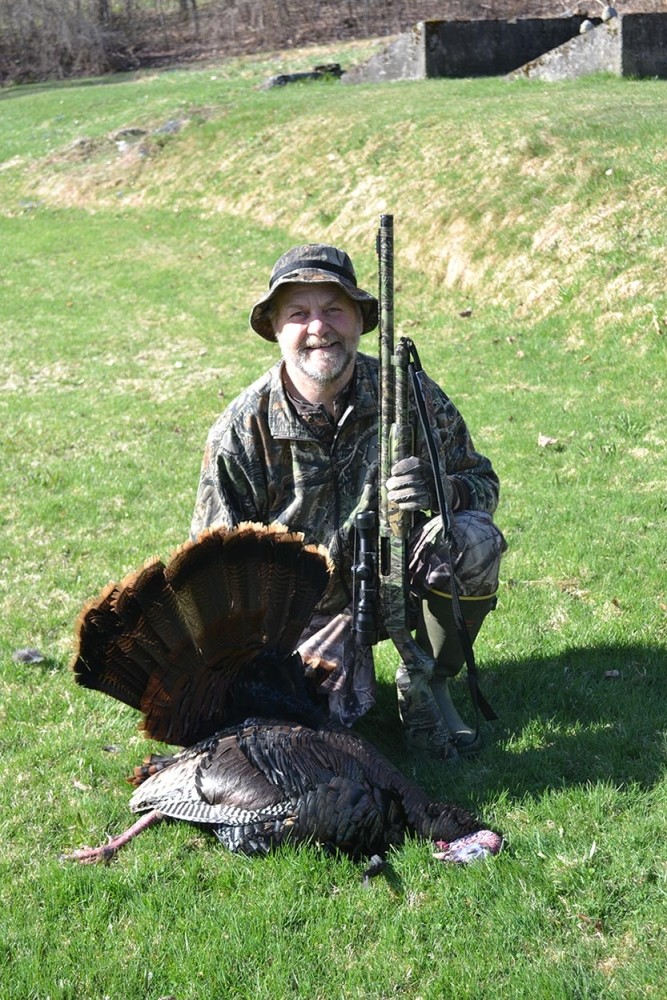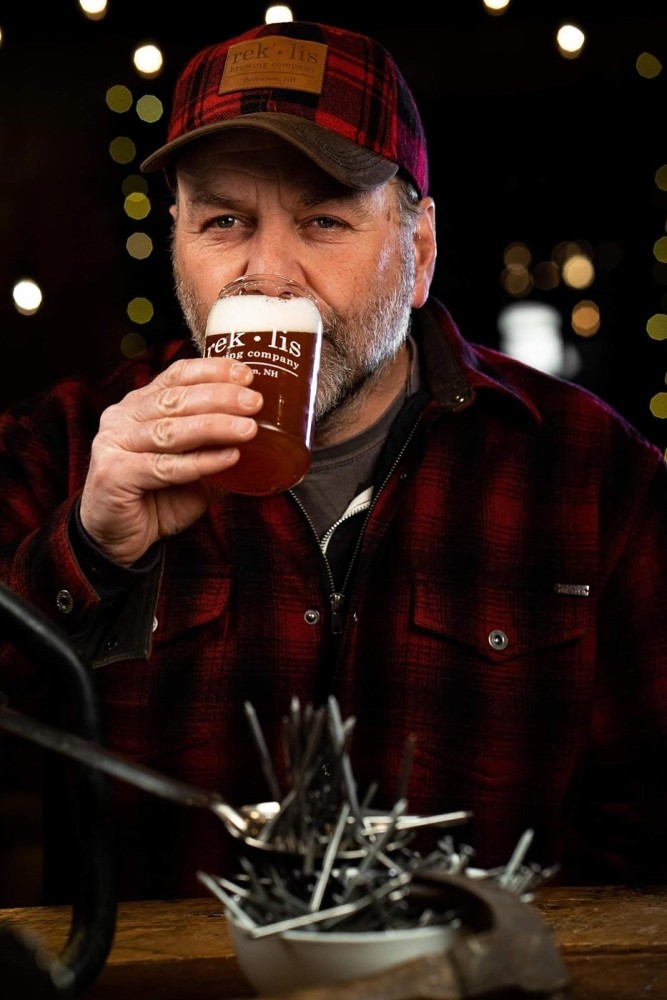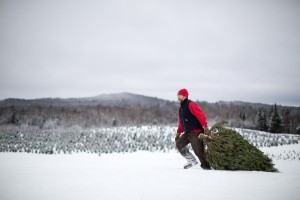
Nigel Manley is an avid outdoorsman, single malt whiskey connoisseur, and soccer referee for local schools. In his long career with the Society for the Protection of New Hampshire Forests (Forest Society), he has done extensive public outreach and marketing work, taught wildlife ecology and history classes, and developed and managed the popular Christmas tree farm at The Rocks, the Forest Society’s northern headquarters. Nigel lives with his wife, Judy Ratzel, and springer spaniel, Keswick, in Bethlehem, New Hampshire, where he operates his own Christmas tree farm, South Farm, and supports the Trees for Troops program, providing free Christmas trees to military families.
My family lived the West Midlands, in the town of Stourbridge near Birmingham, England. We did market gardening at home. We had a shop right at the house. But there was no woods. It was all industrial. My first jobs in the summer were in a steel foundry, a brick factory, a bread factory, a double glazing factory, a place where they loaded Findus frozen foods. I did all those sorts of jobs. I would do that half of the summer to make money, and then I would go to my uncle’s dairy farm and just stay there for room and board so I could learn how to farm. That was much better. I loved that.
I got my degree in agriculture at Reading University in England. And then I ended up in the Minnesota agricultural student trainee program, through the University of Minnesota in the Twin Cities. Two of my friends got their ag degrees at Reading as well, and we all decided that it would be better to go to Minnesota than to get a job. We worked for 8 months on a family farm, and then 3 months – one semester – at the university, and then we had 4 months off. Basically, if you did that and you got good reviews, you could get a work visa. I got a visa and ended up in Ski Hearth Farm in Sugar Hill, New Hampshire.
At the time, the Forest Society had a farmer who leased the farm operation at The Rocks. And he came down to see me, I think it was in October of 1986. My job interview was, “I hear you turn up for work every day.” And – this was like Wednesday or something – “I hear you won’t have any work here past Friday.” And I said, “Both of those are true.” So I went to The Rocks, working for the farmer, milking cows, splitting wood, doing things like that. And I raked leaves and did some grounds work for the Forest Society. They let me earn enough money to live in the apartment at The Rocks. I also waited tables on weekends. I could earn more back then waiting tables on Friday and Saturday night than I could earn all week.
When the farmer decided to move, the Forest Society had to decided what to do with the property. It was like uh oh, now what are we going to do? I remember looking into figures of budgets for sheep, an equine center, dairy again. The Forest Society had to have a crop in the field of some description, because the donors who gave the land had required that. Bruce Hovland, one of the members of the staff in Concord, had a Christmas tree farm. And he suggested doing that. Not only is the land conducive to it, but back then the only pick-your-own products in a big way were apples or Christmas trees. And the Forest Society wanted to get people out on the property.
I had the option of doing Christmas trees or not having a job, so I did Christmas trees. We figured out that we could plant 7,000 trees a year. I’ve always enjoyed marketing and sales, so I said, “OK, we can do that. We can do wholesale, we can do retail,” and just figured it out as I went. But yeah, I had no background in it whatsoever.
Back then, most people were planting balsam fir, trying to get ones that budded out later in the spring so they didn’t get frosted. So we started with that. Not long into it, Good Morning America did an interview about Christmas trees and showed a Fraser fir and told people they were wonderful. And the next year, we got all these calls about Fraser firs. We started planting Fraser firs. Christmas tree species have changed, particularly because it’s hotter and wetter now, and we’re trying to figure out what will grow best.
Three years ago I said, “OK, I want to plant my own trees,” because I wanted to experiment. To make sure there’s no conflict, I’ve separated myself from the tree farm at The Rocks. I am just helping out this year, while they hire a new farmer. The Forest Society is great – my work now is something I can do for 20 hours a week, and involves something that I really enjoy, which is teaching: wildlife programs, history, developing programs on [forensic science pioneer and Rocks former resident] Frances Glessner Lee. Some of these programs take place in the renovated building, the same building that I used to milk cows in. When I got there in 1986 I was milking cows and feeding calves in there. Now, we’re building up a cadre of different programs we can do, which is fantastic.
At South Farm, we’re growing Frasers where the land is really well drained. We’re growing Canaan fir, which is a type of balsam fir from Virginia. And now a lot of farmers are trying exotics, to try to find out what will grow. One I’m having the most success with is Korean fir crossed with balsam fir. They grow fast. They don’t mind wet conditions, and they seem to be doing alright in the heat. We sold our first Korean last year, and we’ve got people that are already cutting them this year. Their needles as they grow almost twist, so you’re looking at the bottom of the needle. So they actually have this blue or silver sheen. They’re gorgeous. Trying to learn how to prune the things is a little taxing.
In April and May we’re planting. Then we go in and do weed control. We try to keep the weeds down within 15 inches of the tree. I use chemical weed control and then I mow. I mow short. You want to get as much airflow as possible through the trees. Because the warmer and hotter it gets, if you don’t get airflow, you get more fungal diseases. I hadn’t really seen those until maybe 15 years ago. I basal prune trees, which I do in usually the third year in the field, and that’s in May as well. I cut the bottom 6 to 8 inches of branches off the trees and again that means I can get fertilizer under the trees, I can mow under the trees, and get that airflow through to keep fungal diseases away.
All summer is mowing. Particularly this summer, because it rained almost every day during July and August. And I start shearing here usually around July 4th. Every tree, no matter what size, has to be sheared every year. So, top growth, side growth, and that’s the biggest labor. I have about 6,400 trees at my farm, and I do all of the pruning myself.
After that is tagging trees, when you go through and rate them. You have to do inventory on a Christmas tree farm, walk through every row of trees, and hang a flag on trees you want cut for wholesale, and figure out what you want for retail. So you have all these different kinds of colored ribbons you put out so you can show what grade the trees are. It’s all based on shearing shape – what the triangle looks like – the color and then density. But every farm is different, and I always warn people who are buying wholesale trees that the only thing that you can do to make sure that you are paying what you feel is the right price for a certain grade of tree is go out and look at the tree. I won’t sell trees from my farm unless the buyers come and look at them.
Harvest is usually around the 10th of November. You harvest all the wholesale trees and have those ready to ship out, and they usually go out anywhere from the week before Thanksgiving to the week after Thanksgiving if people are setting up late. But I’ve definitely noticed a shift in the tree industry. It used to be the first week in December was always the busiest, and now Thanksgiving is busier, which amazes me. For instance, at The Rocks, because it’s such a big farm and we sell so many trees, I started opening the weekend before Thanksgiving because at least you get some of the traffic out of the way. The weird thing about Christmas trees retail is you basically do 85 percent of your sales in eight days.
On South Farm we had a soft opening, and then last year we opened for real. In the first year we did I think 40 trees, and last year we did 180. So that was quite a shift. A lot of friends will come up and help for a few hours, people who just have fun selling the trees. We usually have the fire pit going. Judy and I have three kids, two girls and a boy, and all of them have been smart enough not to go into farming. But they turn up to help. They were all raised at The Rocks and they’re the best workforce you could possibly have. The grandchildren are 10, 3, and 2. The 10-year-old is now going out in the field and helping the customers get their right tree and bring it back. He’s really enjoying that.
I’m an avid turkey hunter, so our wreaths have turkey feathers on them. My wreath decorator told me they would never sell. And they are the ones that sold out first. So we’ve made more this year. And all our swag has Trees for Troops on it. We give 10 percent of everything we sell swag-wise to Trees for Troops.
We’re celebrating the twentieth year anniversary of Trees for Troops. It started when FedEx called the National Christmas Tree Association and they wanted to find out if they could deliver the White House tree. You’re not allowed to do that, to get PR from that, but a couple of smart farmers who were on the board at the time said, “If we got some trees donated, would you deliver them to military bases?” FedEx thought about it and said, “Yeah, we can.” So they did. Our board looked at what was going on with our executive director and we ended up making a separate nonprofit from the association, the Christmas Spirit Foundation, to help our members do good things. I chaired that for 10 years.
We have Tree for Troops sponsors from all walks of life. And there are pickup points for every state. South Farm – my farm – is the pickup point for donated trees from Vermont and New Hampshire farms. We usually manage to gather 450 trees, but this year it looks like it will be closer to 500 that will be donated. We get a list of military bases, usually in August, of bases who would like trees, and how many, and this year it’s 93 different bases. Luckily for us, FedEx is our main sponsor, and they do all the logistics and all the trucking. So they’ll turn up at South Farm in northern New Hampshire and pick up trees and take them everywhere: Texas, Kentucky, New York, Alabama. In the end, Trees for Troops delivers over 16,000 trees a year. Every tree now has two tags. One of the tags will be from whoever donated it, and the other will be from a FedEx employee. Military families will write back and get on Facebook and thank them. It’s an amazing program. It’s been a good thing to be involved with.
I played rugby in England, and got lucky enough to play rugby when I went to university. Which sounds glorious, but no, I was like on the third string. I just enjoyed playing. I did that, and when I got to the States I played a bit of rugby, but it was really hard to find a team that was close enough. So I started playing men’s league soccer with a group. There were people who were setting this up in Littleton, New Hampshire, the next town over. They had no soccer in schools at that time. They wanted to fundraise for that. So the group helped. We sold Christmas trees to pay for the travel costs, to pay for the buses. And in the end we formed the Littleton Soccer Club. I referee at the three local schools here. Two years ago, they asked if I could also help with grade school, and it’s great. Because all of the kids are just learning and having fun. The parents are all really supportive. So what we do is, if there’s a mistake made, we’re allowed as refs to teach what the kids should have done and let them have another go. It’s more fun because it’s a teaching experience.
Anything that’s legal that I can eat, I try to hunt. I started bird hunting first. I got my own gun dog from a friend, who had his own line of dogs. Then I went deer hunting with a few people and found that I enjoyed that. I appreciate the amount of meat that you can get, if you manage to get a deer. Coming from the U.K., I didn’t shoot a deer until I was 30, which is unheard of up here.
I began stream fishing with a friend who was 65, when I was 26. Now I do a lot of boat fishing, right here in northern New Hampshire. I’m very utilitarian. I catch fish. I eat them. And that’s it. I guess I’m going to get to the point where I catch things and let them go, but I haven’t quite figured that out yet. It seems kind of weird.
I started collecting malt whiskey courtesy of my eldest brother, who’s seven years older than me. He worked for Haliburton Oil Company in Scotland, and he would have to pick good single malts to entertain all these executives, particularly the ones who came from the States. And I was really interested in it, so I would tell him what to buy, and then he’d often give me what was left over. And I took it back to my hall residence at university. We could drink in Britain when we were 18, so I had a great bar then.
I do single malt whiskey tastings, Irish malt whiskey tastings. I’ve been working for Rek-lis, the brewery in Bethlehem. I do probably six events a year, where we do a complete meal paired with spirits. And now I do tequila and gin and talk to the crowd and show them how gin is made, why it’s different. We just did a tasting with two Japanese whiskies, an Indian whiskey, and one from Australia. The chef’s exceptional there. I’ll pick the whiskies and tell him what the pairing notes are and then he picks the foods.
Ardbeg is my favorite whiskey. It’s from the Island of Islay, which is where they do all of the heavily peated, smoky whiskies. They’ll release one once a year and I’ll get it. We always go to different distilleries wherever we are in this country or when we go over to Britain. Collecting whiskey is a fun hobby. And it’s a lot easier on the body than Christmas tree farming.


